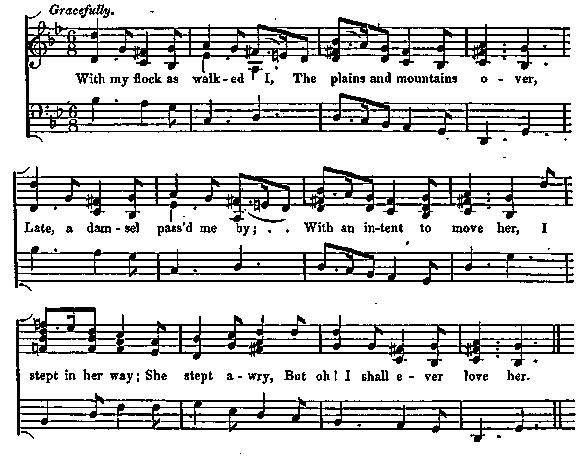Popular Music Of The Olden Time Vol 1
Ancient Songs, Ballads, & Dance Tunes, Sheet Music & Lyrics - online book
| Share page | Visit Us On FB |
|
REIGN OF ELIZABETH. |
157 |
||
|
Reverting to the pavan and galliard, Morley says, " The pavan" (derived from pavo, a peacock) "for grave dancing; galliards, which usually followpavans, they are for a lighter and more stirring kind of dancing." The pavan was sometimes danced by princes and judges in their robes, and by ladies with long trains held up behind them; but usually the galliard followed the pavan, much in the same manner as the gavotte follows the minuet. Butler, in his Principles of Musick, 1636, says, " Of this sort (the Ionic mood) are pavans, invented for a slow and soft kind of dancing, altogether in duple proportion [common time]. Unto which are framed galliards for more quick and nimble motion, always in triple proportion: and, therefore, the triple is oft called galliard time, and the duple pavan time. In this kind is also comprehended the infinite multitude of Ballads, set to sundry pleasant and delightful tunes by cunning and witty composers, with country dances fitted unto them, . . . and which surely might and would be more freely permitted by our sages, were they used as they ought, only for health and recreation."—(p. 8.) At this time Puritanism was nearly at its height.
WITH MY FLOCK AS "WALKED I.
Stafford Smith found this song, with the tune, in a manuscript of about the year 1600, and printed it in his Musica Antiqua, p. 57. I discovered a second copy of the tune in Elizabeth Rogers' MS. Virginal book, in the British Museum, under the name of The faithful Brothers.
The song is evidently in allusion to Queen Elizabeth, and in the usual complimentary style to her beauty, to her vow of virginity, &c. |
|||
|
|
|||
 |
|||